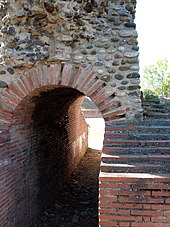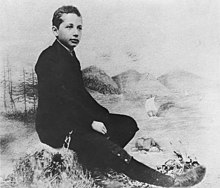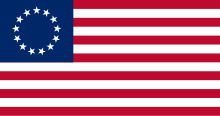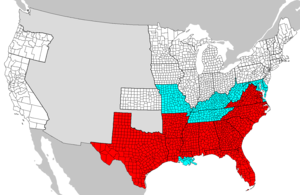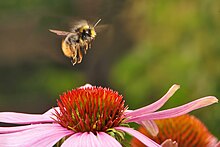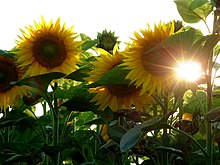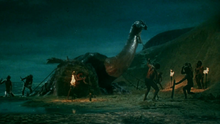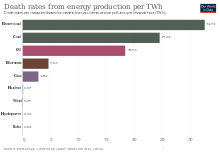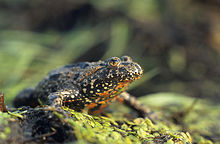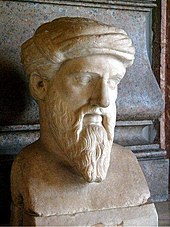Arts and culture
Business
- Federal legal tender laws in the United States do not state that a private business, a person, or an organization must accept cash for payment, though it must be regarded as valid payment for debts when tendered to a creditor.[1]

- Adidas is not an acronym for "All day I dream about sports", "All day I dream about soccer", or "All day I dream about sex". The company was named after its founder Adolf "Adi" Dassler in 1949. The backronyms were jokes published in 1978 and 1981.[2][3][4]
- The "AR" in AR-15 stands for "ArmaLite Rifle", reflecting the company (ArmaLite) that originally manufactured the weapon. They do not stand for "assault rifle" or "automatic rifle".[5][6]
- The Chevrolet Nova sold very well in Latin American markets; General Motors did not need to rename the car. While no va does mean "it doesn't go" in Spanish, nova was easily understood to mean "new".[7]
- The common image of Santa Claus (Father Christmas) as a jolly old man in red robes was not created by The Coca-Cola Company as an advertising gimmick. Santa Claus had already taken this form in American popular culture and advertising by the late 19th century, long before Coca-Cola used his image in the 1930s.[8]
- Netflix was not founded after its co-founder Reed Hastings was charged a $40 late fee by Blockbuster. Hastings made the story up to summarize Netflix's value proposition, and Netflix's founders were actually inspired by Amazon.[9]
- PepsiCo never owned the "6th most powerful navy" in the world after a deal with the Soviet Union. In 1989, Pepsi acquired several decommissioned warships as part of a barter deal.[10][11] The oil tankers were leased out and the other ships sold for scrap.[12] A follow-on deal involved another 10 ships.[13]
Food and cooking
- Searing does not seal moisture in meat; in fact, it causes it to lose some moisture. Meat is seared to brown it, to affect its color, flavor, and texture.[14]
- Twinkies, an American snack cake generally considered to be "junk food", have a shelf life of around 45 days, despite the common claim (usually facetious) that they remain edible for decades.[15][16] Twinkies, with only sorbic acid as an added preservative, normally remain on a store shelf for 7 to 10 days.[17][18]
- With the exception of some perishables, properly stored foods can safely be eaten past their "expiration" dates.[19][20] The vast majority of expiration dates in the United States are regulated by state governments and refer to food quality, not safety; the "use by" date represents the last day the manufacturer warrants the quality of their product.
- Seeds are not the spicy part of chili peppers. In fact, seeds contain a low amount of capsaicin, one of several compounds which induce the hot sensation (pungency) in mammals. The highest concentration of capsaicin is located in the placental tissue (the pith) to which the seeds are attached.[21][22]
- Turkey meat is not particularly high in tryptophan, and does not cause more drowsiness than other foods.[23][24] Drowsiness after holiday meals such as Thanksgiving dinner generally comes from overeating.[24]
- Banana-flavored candy was not intended to mimic the taste of a formerly popular variety of banana. It tastes different from bananas because it is mainly flavored with only one of the many flavor compounds a banana has, isoamyl acetate,[25][26][27] that is also found in a wide variety of fruits and fermented beverages.[28]
Food history

- Fortune cookies are not found in Chinese cuisine, despite their ubiquity in Chinese restaurants in the United States and other Western countries. They were invented in Japan and introduced to the US by the Japanese.[29] In China, they are considered American, and are rare.[30]
- Hydrox is not a knock-off of Oreos. Hydrox, invented in 1908, predates Oreos by four years and outsold it until the 1950s, when Oreos raised prices and the name "Hydrox" became increasingly unappealing due to being said to sound like a laundry detergent brand, after similar new brands of the decade.[31][32][33]
- George Washington Carver was not the inventor of peanut butter.[34][35][36] Peanut butter was used by the Aztecs and Incans as early as the 15th century,[34] and the first peanut butter-related patent was filed by John Harvey Kellogg in 1895.[37] Carver did compile hundreds of uses for peanuts, soybeans, pecans, and sweet potatoes to promote his system of crop rotation.[35] An opinion piece by William F. Buckley Jr. may have been the source of the misconception.[36]
- Potato chips were not invented by a frustrated George Speck in response to a customer, sometimes given as Cornelius Vanderbilt, complaining that his French fries were too thick and not salty enough.[38][39][40] Recipes for potato chips existed in cookbooks as early as 1817.[40][41] The misconception was popularized by a 1973 advertising campaign by the St. Regis Paper Company.[42]
- Spices were not used in the Middle Ages to mask the flavor of rotten meat before refrigeration. Spices were an expensive luxury item; those who could afford them could afford good meat, and there are no contemporaneous documents calling for spices to disguise the taste of bad meat.[43]
- Steak tartare was not invented by Mongol warriors who tenderized meat under their saddles.[44] The dish originated in the early 20th century, in Europe, as a variation on the German-American Hamburg steak.[45][46]
- Whipped cream was not invented by François Vatel at the Château de Chantilly in 1671; the recipe is attested at least a century earlier in France and England,[47] but the name crème chantilly was only popularized in the 19th century.[48]
- Catherine de' Medici and her entourage did not introduce Italian foods to the French royal court and thus create French haute cuisine.[49]
Microwave ovens
- Microwave ovens are not tuned to any specific resonant frequency for water molecules in the food.[50][51][52] They cook food via dielectric heating of polar molecules, including water.[53]
- Microwave ovens do not cook food from the inside out. 2.45 GHz microwaves can only penetrate approximately 1 centimeter (3⁄8 inch) into most foods. The inside portions of thicker foods are mainly heated by heat conducted from the outer portions.[54]
- Microwave ovens do not cause cancer, as microwave radiation is non-ionizing and therefore does not have the cancer risks associated with ionizing radiation such as X-rays. No studies have found that microwave radiation causes cancer, even with exposure levels far greater than normal radiation leakage.[55]
- Microwaving food does not reduce its nutritive value and may preserve it better than other cooking processes due to shorter cooking times.[56]
Film and television
- Ronald Reagan was never seriously considered for the role of Rick Blaine in the 1942 film Casablanca, eventually played by Humphrey Bogart. An early studio press release mentioned Reagan, but the studio already knew that Reagan was unavailable because of his upcoming military service.[57] Indeed, the producer had always wanted Bogart for the part.[58]
- Although it is considered the first modern zombie film, George A. Romero's Night of the Living Dead (1968) did not identify the undead as zombies. Instead they were referred to as "ghouls".[59][60][61][62][63] However, the undead were explicitly called "zombies" in the 1978 sequel Dawn of the Dead, after the term had entered public use in the decade between the films.[61]
- Walt Disney Studios' Snow White and the Seven Dwarfs was not the first animated film to be feature-length. El Apóstol, a lost 1917 Argentine silent film that used cutout animation, is considered the first.[64][65][66] The confusion comes from Snow White being the first animated feature-length film to use cel animation, which is what most animated films were made with following its release,[67] and from El Apóstol's screenings being limited to select theaters in Buenos Aires.[68]
- The 1939 film The Wizard of Oz was not the first film in colour. Kinemacolor, the first successful colour process, was used starting in 1909,[69][70] and the first Technicolor process debuted in 1917.[71][72][73]
Language
|
See also: List of common misconceptions about language learning |
- The pronunciation of coronal fricatives in Spanish did not arise through imitation of a lisping king. Only one Spanish king, Peter of Castile, is documented as having a lisp, and the current pronunciation originated two centuries after his death.[74]
- Sign languages are not the same worldwide. Aside from the pidgin International Sign, each country generally has its own native sign language, and some have more than one.[75]
- Eskimos do not have a disproportionate number of words representing snow in their languages. The myth comes from a misconstruction of Franz Boas' original statement noting that Eskimos had a variety of words for various snow-related concepts; Boas noted that the same was true to a lesser extent for English (see, for example, "blizzard," "flurry" and "squall").[76] However, Eskimo languages do have many more root words for "snow" than English does.[77][78]
- The Hopi people do in fact have a concept of time, and the Hopi language does have ways of expressing temporal concepts, though they are organized differently from those in Western languages.[79]
- The Chinese word for "crisis" (危机) is not composed of the symbols for "danger" and "opportunity"; the first does represent danger, but the second instead means "inflection point" (the original meaning of the word "crisis").[80][81] The myth was perpetuated mainly by a campaign speech from John F. Kennedy.[80]
- The word "gringo" did not originate during the Mexican–American War (1846–1848), the Venezuelan War of Independence (1811–1823), the Mexican Revolution (1910–1920), or from the American Old West (1865–1890) as a corruption of the English lyrics "green grow" in either "Green Grow the Lilacs" (Irish folk song) or "Green Grow the Rushes, O" (English folk song), as sung by US soldiers or cowboys;[82] nor did it originate during any of these times as a corruption of "Green, go home!", in reference to either the green uniforms of American troops[83] or the color of the U.S. dollar.[84] The word originally simply meant "foreigner", and is probably a corruption of the Spanish word griego for "Greek" (along the lines of the idiom "It's Greek to me").[85]
English language
|
Main articles: List of common false etymologies and Common English usage misconceptions |
- Irregardless is a word.[86][87] Nonstandard, slang, or colloquial terms used by English speakers are sometimes alleged not to be real words, despite appearing in numerous dictionaries. All words in English became accepted by being commonly used for a certain period of time; thus, there are many vernacular words currently not accepted as part of the standard language, or regarded as inappropriate in formal speech or writing, but the idea that they are not words is a misconception.[88] Other examples of words that are sometimes alleged not to be words include burglarize, licit,[89] and funnest[90] which appear in numerous dictionaries as English words.[91]
- It is permissible to end a sentence with a preposition.[92] The supposed rule against it originated in an attempt to imitate Latin, but modern linguists agree that it is a natural and organic part of the English language.[93] Similarly, modern style and usage manuals allow split infinitives.[94]
- African American Vernacular English speakers do not simply replace "is" with "be" across all tenses, with no added meaning. In fact, AAVE speakers use "be" to mark a habitual grammatical aspect not explicitly distinguished in Standard English.[95]
- "420" did not originate from the Los Angeles police or penal code for marijuana use.[96] California Penal Code section 420 prohibits the obstruction of access to public land.[96][97] The use of "420" started in 1971 at San Rafael High School, where a group of students would go to smoke at 4:20 pm.[96]
- The word crap did not originate as a back-formation of British plumber Thomas Crapper's aptronymous surname, nor does his name originate from the word crap.[98] The surname "Crapper" is a variant of "Cropper", which originally referred to someone who harvested crops.[99] The word crap ultimately comes from Medieval Latin crappa.[100]
- The use of the word faggot as a pejorative for homosexual men was not derived from the burning of homosexuals at the stake with a bundle of sticks. Homosexuality was never punished with immolation in either England or its colonies. The actual etymology is unknown; it may come from an insult for unpleasant old women, or from British slang for a student that does errands for their superior.[101][102][103]
- The word fuck did not originate in the Middle Ages as an acronym for either "fornicating under consent of king" or "for unlawful carnal knowledge", either as a sign posted above adulterers in the stocks, or as a sign on houses visible from the road during the Black Death. Nor did it originate as a corruption of "pluck yew" (an idiom falsely attributed to the English for drawing a longbow).[104] It is most likely derived from Middle Dutch or other Germanic languages, where it either meant "to thrust" or "to copulate with" (fokken in Middle Dutch), "to copulate", or "to strike, push, copulate" or "penis".[104][105] Either way, these variations would have been derived from the Indo-European root word -peuk, meaning "to prick".[104]
- The expression "rule of thumb" did not originate from an English law allowing a man to beat his wife with a stick no thicker than his thumb, and there is no evidence that such a law ever existed.[106] The false etymology has been broadly reported in media including Time magazine (1983), The Washington Post (1989) and CNN (1993).[107] The expression originates from the seventeenth century from various trades where quantities were measured by comparison to the width or length of a thumb.[108][109]
- The word the was never pronounced or spelled "ye" in Old or Middle English.[110] The confusion, seen in the common stock phrase "ye olde", derives from the use of the character thorn (þ), which in Middle English represented the sound now represented in Modern English by "th". Early printing presses often lacked types for the letter þ, meaning that "þͤ" (
 ) and "þe" were substituted with the visually similar "yͤ" and "ye", respectively.[111]
) and "þe" were substituted with the visually similar "yͤ" and "ye", respectively.[111] - The anti-Italian slur wop did not originate from an acronym for "without papers" or "without passport";[112] it is actually derived from the term guappo (roughly meaning thug or "dandy"), from Spanish guapo.[113]

- Xmas did not originate as a secular plan to "take the Christ out of Christmas".[114] X represents the Greek letter chi, the first letter of Χριστός (Christós), "Christ" in Greek,[115] as found in the chi-rho symbol ΧΡ since the 4th century. In English, "X" was first used as a scribal abbreviation for "Christ" in 1100; "X'temmas" is attested in 1551, and "Xmas" in 1721.[116]
Law, crime, and military
- It is not necessary to wait 24 hours before filing a missing person report. When there is evidence of violence or of an unusual absence, it is important to start an investigation promptly.[117][118] Criminology experts say the first 72 hours in a missing person investigation are the most critical.[119]
- Twinkies were not claimed to be the cause of San Francisco mayor George Moscone's and supervisor Harvey Milk's murders. In the trial of Dan White, the defense successfully argued White's diminished capacity as a result of severe depression. While eating Twinkies was cited as evidence of this depression, it was never claimed to be the cause of the murders.[120]
- The US Armed Forces have generally forbidden military enlistment as a form of deferred adjudication (that is, an option for convicts to avoid jail time) since the 1980s. US Navy protocols discourage the practice, while the other four branches have specific regulations against it.[121]
- The United States does not require police officers to identify themselves as police in the case of a sting or other undercover work, and police officers may lie when engaged in such work.[122] Claiming entrapment as a defense instead focuses on whether the defendant was induced by undue pressure (such as threats) or deception from law enforcement to commit crimes they would not have otherwise committed.[123]

- Crime in the United States decreased between 1993 and 2017. The violent crime rate fell 49%,[124] and the number of gun homicides also decreased.[125]
- The First Amendment to the United States Constitution generally prevents only government restrictions on the freedoms of religion, speech, press, assembly, or petition,[126] not restrictions imposed by private individuals or businesses[127] unless they are acting on behalf of the government.[128] Other laws may restrict the ability of private businesses and individuals to restrict the speech of others.[129]
- It is not illegal in the US to shout "fire" in a crowded theater. Although this is often given as an example of speech that is not protected by the First Amendment, it is not now nor has it ever been the law of the land. The phrase originates from Justice Oliver Wendell Holmes Jr.'s opinion in the United States Supreme Court case Schenck v. United States in 1919, which held that the defendant's speech in opposition to the draft during World War I was not protected free speech. However, that case was not about shouting "fire" and it was later overturned by Brandenburg v. Ohio in 1969.[130][131][132]
- Neither the Mafia nor other criminal organizations regularly use or have used cement shoes to drown their victims.[133] There are only two documented cases of this method being used in murders: one in 1964 and one in 2016 (although, in the former, the victim had concrete blocks tied to his legs rather than being enclosed in cement).[134] The French Army did use cement shoes on Algerians killed in death flights during the Algerian War.[135]
- In the United States, a defendant may not have their case dismissed simply because they were not read their Miranda rights at the time of their arrest. Miranda warnings cover the rights of a person when they are taken into custody and then interrogated by law enforcement.[136][137] If a person is not given a Miranda warning before the interrogation is conducted, statements made by them during the interrogation may not be admissible in a trial. The prosecution may still present other forms of evidence, or statements made during interrogations where the defendant was read their Miranda rights, to get a conviction.[138]
- Chewing gum is not punishable by caning in Singapore. Although importing and selling chewing gum has been illegal in Singapore since 1992, and corporal punishment is still an applicable penalty for certain offenses in the country, the two facts are unrelated; chewing gum-related offenses have always been only subject to fines, and the possession or consumption of chewing gum itself is not illegal.[139][140]
- Employees of the international police organization Interpol cannot conduct investigations, arrest criminals or use fake passports. They only provide support for international communication between law enforcement agencies of sovereign states.[141][142]
- Chalk outlines in crime scenes are rare in modern investigations, despite being a popular trope in fiction.[143]
- No cases have been proven of strangers killing or permanently injuring children by intentionally hiding poisons, drugs, or sharp objects such as razor blades in candy during Halloween trick-or-treating.[144] However, in rare cases, adult family members have spread this story to cover up filicide or accidental deaths. Folklorists, scholars, and law enforcement experts say that the story that strangers put poison into candy and give that candy to trick-or-treating children has been "thoroughly debunked".[145][144]
Literature
|
Main article: Wikiquote:Misquotations |
- Many quotations are incorrect or attributed to people who never uttered them, and quotations from obscure or unknown authors are often attributed to more famous figures. Commonly misquoted individuals include Mark Twain, Albert Einstein, Adolf Hitler, Winston Churchill, Abraham Lincoln, William Shakespeare, Confucius, Sun Tzu, and the Buddha.[146]
- Mary Shelley's 1818 novel Frankenstein is named after the fictional scientist Victor Frankenstein, who created the sapient creature in the novel, not the creature itself, which is never named and is called Frankenstein's monster. However, as later adaptations started to refer to the monster itself as Frankenstein, this usage became well-established, and some no longer regard it as erroneous.[147][148]
- Ernest Hemingway did not author the flash fiction story "For sale: baby shoes, never worn". The story existed as early as 1906, and it was not attributed to him until decades after he died.[149][150][151]
Music
|
See also: Mondegreen § In songs |
Classical music
- The musical interval tritone was never thought to summon the devil, was not banned by the Catholic Church,[152] and was not associated with devils during the Middle Ages or Renaissance.[153] Early medieval music used the tritone in Gregorian chant for certain modes.[154] Guido of Arezzo (c. 991 – c. 1033) was the first theorist to discourage the interval,[154][155] while rock musicians popularized this myth to justify their use of the tritone.[156]
- Mozart did not die from poisoning, and was not poisoned by his colleague Antonio Salieri or anyone else.[157] The false rumor originated soon after Salieri's death and was dramatized in Alexander Pushkin's play Mozart and Salieri (1832), and later in the 1979 play Amadeus by Peter Shaffer and the subsequent 1984 film Amadeus.[158]
- The minuet in G major by Christian Petzold is commonly attributed to Johann Sebastian Bach, although the piece was identified in the 1970s as a movement from a harpsichord suite by Petzold. The misconception stems from Notebook for Anna Magdalena Bach, a book of sheet music by various composers (mostly Bach) in which the minuet is found.[159] Compositions that are doubtful as works of Bach are cataloged as "BWV Anh.", short for "Bach-Werke-Verzeichnis Anhang" ("Bach works catalogue annex"); the minuet is assigned to BWV Anh. 114.
- Listening to Mozart or classical music does not enhance intelligence (or IQ). A study from 1993 reported a short-term improvement in spatial reasoning.[160][161] However, the weight of subsequent evidence supports either a null effect or short-term effects related to increases in mood and arousal, with mixed results published after the initial report in Nature.[162][163][164][165]
- The "Minute Waltz" takes, on average, two minutes to play as originally written.[166] Its name comes from the adjective minute, meaning "small", and not the noun spelled the same.[167]
Popular music
- "Edelweiss" is not the national anthem of Austria, but an original composition created for the 1959 musical The Sound of Music.[168] The Austrian national anthem is "Land der Berge, Land am Strome" ("Land of the Mountains, Land on the River [Danube]").[169] The edelweiss is also a national symbol of Austria.[170]
- The Monkees did not outsell the Beatles' and the Rolling Stones' combined record sales in 1967. Michael Nesmith originated the claim in a 1977 interview as a prank.[171]
- The Rolling Stones were not performing "Sympathy for the Devil" at the 1969 Altamont Free Concert when Meredith Hunter was stabbed to death by a member of the local Hells Angels chapter that was serving as security. While the incident began while the band was performing the song, prompting a brief interruption before the Stones finished it, the actual stabbing occurred later as the band was performing "Under My Thumb".[172] The misconception arose from mistaken reporting in Rolling Stone.[173]
- The Beatles' 1965 appearance at Shea Stadium was not the first time that a rock concert was played at a large, outdoor sports stadium in the U.S. Such venues were employed by Elvis Presley in the 1950s and the Beatles themselves in 1964.[174]
- Concept albums did not begin with rock music in the 1960s. The format had already been employed by singers such as Frank Sinatra in the 1940s and 1950s.[175]
- Phil Collins did not write his 1981 hit "In the Air Tonight" about witnessing someone drowning and then confronting the person in the audience who let it happen. According to Collins himself, it was about his emotions when divorcing from his first wife.[176]
Religion
Buddhism
- The historical Buddha is not known to have been fat. The chubby monk known as the "fat Buddha" or "laughing Buddha" in the West is a 10th-century Chinese Buddhist folk hero by the name of Budai.[177]
Christianity
- Jesus was most likely not born on December 25, when his birth is traditionally celebrated as Christmas. It is more likely that his birth was in either the season of spring or perhaps summer. Although the Common Era ostensibly counts the years since the birth of Jesus,[178] it is unlikely that he was born in either AD 1 or 1 BC, as such a numbering system would imply. Modern historians estimate a date closer to between 6 BC and 4 BC.[179]
- The Bible does not say that exactly three magi came to visit the baby Jesus, nor that they were kings, or rode on camels, or that their names were Caspar, Melchior, and Balthazar, nor what color their skin was. Three magi are inferred because three gifts are described, but the Bible says only that there was more than one magus.[180][181][182][183][184][185]

- The idea that Mary Magdalene was a prostitute before she met Jesus is not found in the Bible or in any of the other earliest Christian writings. It has been a disputed doctrine in several theological traditions whether Mary Magdalene, Mary of Bethany (who anoints Jesus' feet in John 11:1–12), and the unnamed "sinful woman" who anoints Jesus' feet in Luke 7:36–50 were the same woman.[186][187]
- Paul the Apostle did not change his name from Saul. He was born a Jew, with Roman citizenship inherited from his father, and thus carried both a Hebrew and a Greco-Roman name from birth, as mentioned by Luke in Acts 13:9: "...Saul, who also is called Paul...".[188]
- The Roman Catholic dogma of the Immaculate Conception is unrelated to the Christian doctrine that Mary conceived and gave birth to Jesus while remaining a virgin. The Immaculate Conception is the belief that Mary was free of original sin from the moment of her own conception. A less common mistake is to think that the Immaculate Conception means that Mary herself was conceived without sexual intercourse.[189][190]
- Roman Catholic dogma does not say that the pope is either sinless or always infallible.[191] Catholic dogma since 1870 does state that a dogmatic teaching contained in divine revelation that is promulgated by the pope (deliberately, and under certain very specific circumstances; generally called ex cathedra) is free from error, although official invocation of papal infallibility is rare. Most theologians state that canonizations meet the requisites.[192] Otherwise, even when speaking in his official capacity, dogma does not hold that he is always free from error.
- St. Peter's Basilica is not the mother church of Roman Catholicism, nor is it the official seat of the Pope. These equivalent distinctions belong to the Archbasilica of Saint John Lateran, which is located in Rome outside of Vatican City but over which the Vatican has extraterritorial jurisdiction. This also means that St. Peter's is not a cathedral in the literal sense of that word. St. Peter's is, however, used as the principal church for many papal functions.[193]
- Members of the Church of Jesus Christ of Latter-day Saints (LDS Church) no longer practice polygamy.[194] However, a widower may be "sealed" to another wife, and is considered a polygamist in the hereafter.[195] Currently, the LDS Church excommunicates any members who practice "living" polygamy within the organization.[196] Some Mormon fundamentalist sects do practice polygamy.[197]
- Saint Augustine did not say "God created hell for inquisitive people".[198] He actually said: "I do not give the answer that someone is said to have given (evading by a joke the force of the objection), 'He was preparing hell for those who pry into such deep subjects.' ... I do not answer in this way. I would rather respond, 'I do not know,' concerning what I do not know than say something for which a man inquiring about such profound matters is laughed at, while the one giving a false answer is praised."[199] So Augustine is saying that he would not say this and that he does not know the answer to the question.
- The First Council of Nicaea did not establish the books of the Bible. The Old Testament had likely already been established by Hebrew scribes before Christ. The development of the New Testament canon was mostly completed in the third century before the Nicaea Council was convened in 325;[200] it was finalized, along with the deuterocanon, at the Council of Rome in 382.[201]
Islam
- Most Muslim women do not wear a burqa (also transliterated as burka or burkha), which covers the body, head, and face, with a mesh grille to see through. Many Muslim women cover their hair and face (excluding the eyes) with a niqāb, or just their hair with a hijab[202] and many Muslim women wear neither face nor head coverings of any kind.[203]
- A fatwa is a non-binding legal opinion issued by an Islamic scholar under Islamic law; it is therefore commonplace for fatwā from different authors to disagree. The misconception[204] that it is a death sentence stems from a fatwā issued by Ayatollah Ruhollah Khomeini of Iran in 1989 where he said that the author Salman Rushdie had earned a death sentence for blasphemy.[205]
- The word "jihad" does not always mean "holy war"; its literal meaning in Arabic is "struggle". While there is such a thing as "jihad bil saif", or jihad "by the sword",[206] it can be any spiritual or moral effort or struggle,[207][208] such as seeking knowledge, putting others before oneself, and inviting others to Islam.[209]
- The Quran does not promise martyrs 72 virgins in heaven. It does mention that virgin female companions,[210] houri, are given to all people, martyr or not, in heaven, but no number is specified. The source for the 72 virgins is a hadith in Sunan al-Tirmidhi by Imam Tirmidhi.[211][212] Hadiths are sayings and acts of Muhammad as reported by others, not part of the Quran itself.[213][211]
Judaism
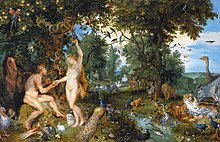
- The forbidden fruit mentioned in the Book of Genesis is never identified as an apple,[214] as widely depicted in Western art. The original Hebrew texts mention only tree and fruit.[215]
- While tattoos are forbidden by the Book of Leviticus, Jews with tattoos are not barred from being buried in a Jewish cemetery, just as violators of other prohibitions are not barred.[216]
Sports
- The name golf is not an acronym for "Gentlemen Only, Ladies Forbidden".[217][218][219] It may have come from the Dutch word kolf or kolve, meaning "club",[218] or from the Scottish word goulf or gowf meaning "to strike or cuff".[217]
- Baseball was not invented by Abner Doubleday, nor did it originate in Cooperstown, New York. It is believed to have evolved from other bat-and-ball games such as cricket and rounders and first took its modern form in New York City.[220]

- The black belt in martial arts does not necessarily indicate expert level or mastery. It was introduced for judo in the 1880s to indicate competency at all of the basic techniques of the sport. Promotion beyond 1st dan (the first black belt rank) varies among different martial arts.[221]
- The use of triangular corner flags in English football is not a privilege reserved for those teams that have won an FA Cup in the past[222] as depicted in a scene in the film Twin Town. The Football Association's rules are silent on the subject, and often the decision over what shape flag to use has been up to the individual club's groundskeepers.[223]
- India did not withdraw from the 1950 FIFA World Cup because their squad played barefoot, which was against FIFA regulations.[224] In reality, India withdrew because the country's managing body, the All India Football Federation (AIFF), was insufficiently prepared for the team's participation and gave various reasons for withdrawing, including a lack of funding and prioritizing the Olympics.[225]
Video games
- There is no definitive proof that violent video games cause people to become violent. Some studies have found no link between aggression and violent video games,[226][227] and the popularity of gaming has coincided with a decrease in youth violence.[228][229] The moral panic surrounding video games in the 1980s through to the 2020s, alongside several studies and incidents of violence and legislation in many countries, likely contributed to proliferating this idea.[230][231]
- The so-called "Nuclear Gandhi" glitch, in which peaceful leader Mahatma Gandhi would become unusually aggressive if democracy was adopted,[232] did not exist in either the original Civilization game or Civilization II. The games' designer Sid Meier attributed the origins of the rumor to both a TV Tropes thread and a Know Your Meme entry,[233] while Reddit and a Kotaku article helped popularize it.[234] Gandhi's supposed behavior did appear in the 2010 Civilization V[233] as a joke, and in 2016's VI[235] as a reference to the legend.
- The Japanese government did not pass a law banning Square Enix from releasing the Dragon Quest games on weekdays due to its causing too many schoolchildren to cut class. The only extent of the government's involvement was that the National Diet held hearings over rises in muggings caused by the release of Dragon Quest III.[236][237][238][239]
- The release of Space Invaders in 1978 did not cause a shortage of ¥100 coins in Japan. Production of ¥100 coins was unusually low that year[240][241] and silver speculators hoarded or imported them for their high silver mix.[240][242] Both an advertising campaign by Taito and an erroneous 1980 article in New Scientist is the source of this claim.[241]






